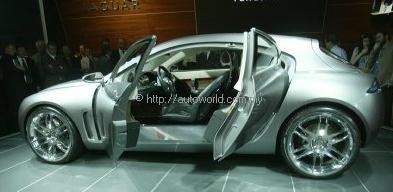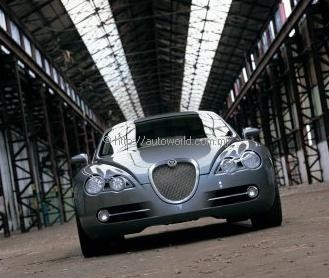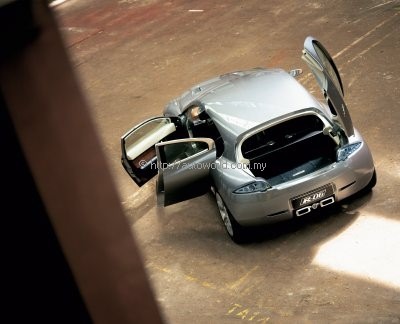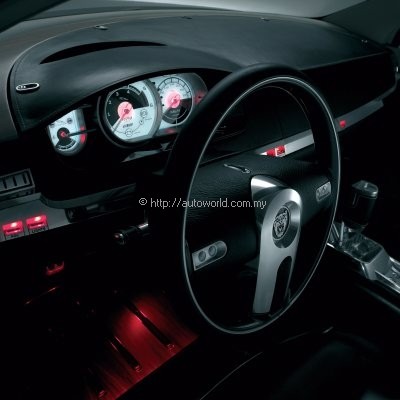Jaguar RD-6: Vision of Premium Motoring in Future
Designing a new model for a marque like Jaguar can be a big challenge when one considers all the tradition it has and its ‘DNA’. One has to understand the past to design for the future and with the RD-6 Concept, Jaguar’s designers have seized the opportunity to realise their ideas for the future of the Jaguar marque well before they appear in production form.
Observers will point to ‘classic’ Jaguar design cues – such as the grille – on the R-D6, but it is important to realise that such features are there not because they commemorate Jaguar’s past, but because they are intrinsically ‘right’ for a thoroughly modern Jaguar.
The R-D6 also takes advantage of Jaguar’s lightweight structure strategy, as pioneered in the new XJ saloon. Using aluminium and composite materials for the chassis and body, it weighs just 1500 kgs. This allows it to capitalise on the power – and, more importantly, the torque – delivered by its V6 engine.
And it’s the engine that will surprise many people – although, when you think about it, a high-performance 2.7-litre turbodiesel engine makes perfect sense. Confirming Jaguar as a potent new force in the world of large-capacity diesels, the bi-turbo V6 is a tuned version of the engine that will make its debut in the S-Type in 2004. With horsepower in excess of 169 kW/230 bhp and a massive 500 Nm of torque, the V6 diesel engine endows R-D6 with the pace to satisfy its looks and R-Performance rating. Acceleration from standstill to the benchmark 60 mph takes less than six seconds, claims Jaguar, with top speed electronically-limited 248 km/h.
At 4330 mm long, the R-D6 is 342 mm shorter than Jaguar’s smallest car, the X-Type saloon – and 760 mm shorter than an XK8 coupé. The compact length is aided by short overhangs front and rear (800 mm and 695 mm, respectively) and yet there is a generous wheelbase of 2840 mm.
To ensure the R-D6 is a true 4-seater, the design team refused to compromise on width or height (2150 mm) but succeeded nonetheless in crafting a beautifully compact coupé that has all the road presence – and more – that you expect of a Jaguar.
The headlights reveal a fresh interpretation of the twin-lamp style featured by Jaguars so successfully for many years. Both front and rear lights use LED technology to deliver the best possible function while maintaining a beautiful form.
For many, though, it will be the details that make R-D6 so irresistibly attractive. Details such as the flush-mounted door handles, which pivot on the front edge to activate an electrical actuator that opens the door; the centrally mounted twin-pipe exhausts; the aluminium boot finisher engraved with the Jaguar script; or even the Leaper on the back of the car.
The aluminium chassis of the R-D6 is similar to that of the new XJ and is constructed using many of the same advanced technologies, with all the accompanying advantages, including outstanding strength, robustness and durability in a true lightweight architecture.
Castings such as the front suspension turrets have also benefited from techniques used in the new XJ, while the body is of aluminium and composite materials.
The R-D6 rides on 21-inch wheels, machined from solid aluminium specifically for this car. They are shod with unique, ultra-low-profile Pirelli tyres: 255/30 R21 on the front and a massive 275/30 R21 on the rear. Look through the spokes of the beautiful wheels and you’ll see Jaguar R-Performance discs and calipers.
To fully appreciate the interior of the R-D6 will probably take a while, partly because one would spend as much time touching as looking. The materials in the cabin are a blend of classic with a contemporary twist and modern bordering on the futuristic.
Aluminium features extensively in both milled and formed guise. Two types of leather – lightly grained, carbon-black aniline and 8 mm thick black saddle leather – are used throughout the interior. Satin-finish Black American Walnut veneer complements the Piano Black gloss veneer that was introduced on the new XJ. The seat is constructed with internal ducts to allow heating or cooling according to driver preference.
It is the view straight ahead from the driver’s seat that shows exactly what sort of car the R-D6 is. Pride of place goes to the dial pack, encased in aluminium and inherently sports-focused. The tachometer is positioned centrally, with the speedometer smaller and to the right. To the other side, in an adjoining ‘pod’, are the usual fuel and temperature gauges and other warning lights. All the dial faces have a white ceramic appearance and R-Performance branding, and a milled aluminium rear-view mirror looks perfectly at home. This blend of racetrack and luxury road styles is typical of the R-D6 and emphasises its seductive nature.
A broad, solid aluminium ‘switch beam’, topped by an aniline leather-trimmed lower instrument panel, runs across the facia. It is broken in the centre by a cover for the navigation and ‘infotainment’ display screen, revealed when the cover swivels backwards into the instrument panel. The touch-sensitive screen, developed by Alpine Electronics, features unique ‘Shutter LCD’ technology that allows passengers to watch a moving image – for example, a DVD – while the driver sees only the essential driving functions: navigation, climate-control etc.
Something unique will be found in the top of the gearshift, below a swivelling top piece. Much like the safety-catch on a gun – or the top of a fighter aircraft joystick – this covers a silver button with a very important duty. Press it and the V6 engine – and the R-D6 – springs into life. Just the kind of dramatic touch you’d expect of a Jaguar!
“Respect for a glorious heritage doesn’t stop us putting in place the foundations for future generations of thrilling, dynamic Jaguars that aren’t afraid to challenge perceptions. That’s what the R-D6 is all about,” is how Julian Thomson Chief Designer, Advanced Design, at Jaguar Cars sums up the latest concept car from Jaguar.
 |





























